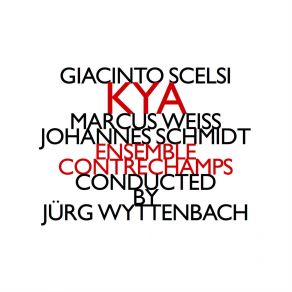Giacinto Scelsi: KYA
Download links and information about Giacinto Scelsi: KYA by Giacinto Scelsi, Marcus Weiss, Ensemble Contrechamps, Philippe Racine. This album was released in 1999 and it belongs to Classical genres. It contains 14 tracks with total duration of 55:36 minutes.

|
|
|---|---|
| Artist: | Giacinto Scelsi, Marcus Weiss, Ensemble Contrechamps, Philippe Racine |
| Release date: | 1999 |
| Genre: | Classical |
| Tracks: | 14 |
| Duration: | 55:36 |
| Buy it NOW at: | |
| Buy on iTunes $9.99 | |
Tracks
[Edit]| No. | Title | Length |
|---|---|---|
| 1. | Kya (1959): I (featuring Jürg Wyttenbach / Jurg Wyttenbach) | 5:51 |
| 2. | Kya (1959): II (featuring Jürg Wyttenbach / Jurg Wyttenbach) | 8:12 |
| 3. | Kya (1959): III (featuring Jürg Wyttenbach / Jurg Wyttenbach) | 2:57 |
| 4. | Ixor (1956) | 3:29 |
| 5. | Rucke di Guck (1957): I | 2:31 |
| 6. | Rucke di Guck (1957): II | 3:04 |
| 7. | Rucke di Guck (1957): III | 3:40 |
| 8. | Tre Pezzi (1956): I (featuring Jürg Wyttenbach / Jurg Wyttenbach) | 2:55 |
| 9. | Tre Pezzi (1956): II (featuring Jürg Wyttenbach / Jurg Wyttenbach) | 3:58 |
| 10. | Tre Pezzi (1956): III (featuring Jürg Wyttenbach / Jurg Wyttenbach) | 2:31 |
| 11. | Yamaon (1954-58): I (featuring Jürg Wyttenbach / Jurg Wyttenbach) | 3:24 |
| 12. | Yamaon (1954-58): II (featuring Jürg Wyttenbach / Jurg Wyttenbach) | 5:08 |
| 13. | Yamaon (1954-58): III (featuring Jürg Wyttenbach / Jurg Wyttenbach) | 3:48 |
| 14. | Maknongan (1976) (featuring Jürg Wyttenbach / Jurg Wyttenbach) | 4:08 |
Details
[Edit]In order to listen to the work of Giancinto Scelsi, to really hear it, one has to imagine music in a different order that is usually prescient. All notions of melody and harmony, dissonance and consonance have to be tossed out the window — at least temporarily. Then indications of time and space are to be stored off to the side for employ later. What is left are two things: vibration, and finally, sound itself. Scelsi felt his role as a composer was to be a medium for sound and vibration, reduce them to essences, the endless microvariables that vibrations employ to make one sound into another, and then transmit them, sound upon transformed sound to the page where notions of interval, time, tonality, etc., would be ordered according to their real purpose. If this sounds austere, it is. To dedicate one's life's work to find ways of combining essences to create via the input of both individual musicians and listeners, a music that would transmit the cosmos for the purpose of transformation, is no mean task. But Scelsi accomplished this in everything he wrote from 1954 on. His long tonal investigations where structure was dependent on things like the breath of the musician and the tone with which he played his instrument were part and parcel the building blocks to a sonic and spiritual ascendancy that he was able to tap into seemingly at will. The six elements of this program, which are so rich and mysterious they need not be discussed individually, offer an entirely new vision of music, one that is as full of the future and the past (not musical so much as trans-cultural), as to be literally timeless. They are transformational because they couldn't be anything less: the composer was changed as a result of his willingness to surrender his role as arbiter of the destination of his music. We, in being active spiritual participants in a musical language of such color and vibrational metaphor, are also changed perceptually to hear music not so much as one language of expression but many, culled together from a single place the essence of one vibration upon another to create a single sound. This is the finest of Hat's continuing series on the music of Scelsi.